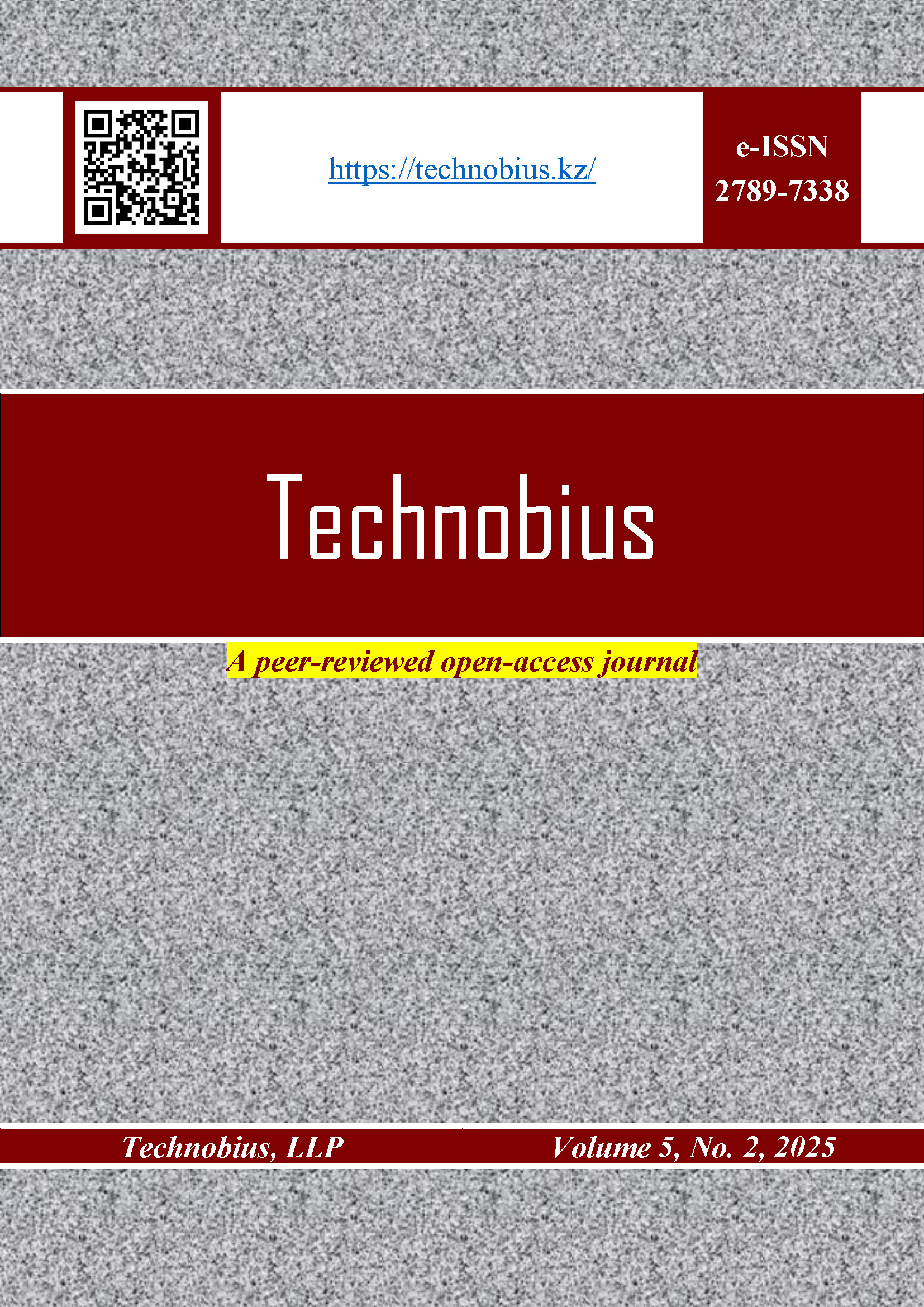Improvement of the crack resistance of reinforced concrete sleepers using modified concretes
DOI:
https://doi.org/10.54355/tbus/5.2.2025.0078Keywords:
modified fiber-reinforced concrete, reinforced concrete, crack resistance, concrete sleepers, fiberAbstract
This paper presents research on the potential use of modified fiber-reinforced concrete for reinforced concrete sleepers, intending to increase their strength characteristics, crack resistance, and service life. To investigate the influence of reinforcing elements on the crack resistance of heavy concrete, chopped basalt fiber and, for comparison, polypropylene fiber were added to the concrete mix, both of which have shown promising performance. The results of the study showed that the modified heavy concrete exhibited improved crack resistance due to the formation of additional low-basic calcium hydrosilicates, compaction, and strengthening of the cement matrix, as well as the contribution of fibers to the formation of a spatially reinforced cement stone structure. The nature of the fracture of prism samples made from modified concrete and their crack resistance characteristics were evaluated. The results showed that samples with basalt fiber had a 40.59% increase in maximum load, a 40.5% increase in the conditional stress intensity factor, and a 40.49% increase in bending stress compared to the reference samples without fiber. In addition, the samples with basalt fiber demonstrated increases of 7.1%, 6.93%, and 6.9% in maximum load, bending stress, and stress intensity factor, respectively, compared to samples containing polypropylene fiber.
Downloads
Metrics
References
R. Chen, X. Zhao, Z. Wang, H. Jiang, and X. Bian, “Experimental study on dynamic load magnification factor for ballastless track-subgrade of high-speed railway,” Journal of Rock Mechanics and Geotechnical Engineering, vol. 5, no. 4, pp. 306–311, Aug. 2013, doi: 10.1016/j.jrmge.2013.04.004. DOI: https://doi.org/10.1016/j.jrmge.2013.04.004
GOST 33320-2015 Reinforced concrete sleepers for railways. General technical conditions. 2019.
M. Afroz, I. Patnaikuni, and S. Venkatesan, “Chemical durability and performance of modified basalt fiber in concrete medium,” Constr Build Mater, vol. 154, pp. 191–203, Nov. 2017, doi: 10.1016/j.conbuildmat.2017.07.153. DOI: https://doi.org/10.1016/j.conbuildmat.2017.07.153
C. J. Slebi-Acevedo, P. Lastra-González, P. Pascual-Muñoz, and D. Castro-Fresno, “Mechanical performance of fibers in hot mix asphalt: A review,” Constr Build Mater, vol. 200, pp. 756–769, Mar. 2019, doi: 10.1016/j.conbuildmat.2018.12.171. DOI: https://doi.org/10.1016/j.conbuildmat.2018.12.171
V. P. Sychev, D. V. Ovchinnikov, A. Yu. Abdurashitov, V. A. Pokatsky, and A. V. Sycheva, “Rails life cycle evaluation depending on the operating conditions,” 2023, p. 020010. doi: 10.1063/5.0104545. DOI: https://doi.org/10.1063/5.0104545
J. P. Romualdi and G. B. Batson, “Mechanics of crack arrest in concrete,” in American Concrete Institute, ACI Special Publication, 2008. doi: 10.1061/jmcea3.0000381. DOI: https://doi.org/10.1061/JMCEA3.0000381
Y. Wang, S. Hu, and X. Sun, “Experimental investigation on the elastic modulus and fracture properties of basalt fiber–reinforced fly ash geopolymer concrete,” Constr Build Mater, vol. 338, 2022, doi: 10.1016/j.conbuildmat.2022.127570. DOI: https://doi.org/10.1016/j.conbuildmat.2022.127570
D. A. Akhmetov et al., “The Effect of Low-Modulus Plastic Fiber on the Physical and Technical Characteristics of Modified Heavy Concretes Based on Polycarboxylates and Microsilica,” Materials, vol. 15, no. 7, p. 2648, Apr. 2022, doi: 10.3390/ma15072648. DOI: https://doi.org/10.3390/ma15072648
GOST 31108-2016 Cements for general construction. Technical conditions. 2019.
GOST 8735-88 Sand for construction works. Methods of testing. 2018.
GOST 8736-2014 Sand for construction works. Technical conditions. 2019.
GOST 8267-93 Crushed stone and gravel from dense rocks for construction works. Technical conditions. 2018.
GOST 24211-2008 Additives for concrete and mortars. General technical conditions. 2010.
GOST 58894-2020 Condensed microsilica for concrete and mortars. Technical conditions. 2020.
TU 5952-002-13307094-08 Chopped basalt fiber. 2008.
Yu. M. Bazhenov, Technology of concrete. Moscow: ASV, 2011.
S. S. Kaprielov, A. V. Sheynfeld, I. A. Chilin, V. G. Dondukov, and N. M. Selyutin, “Modified concrete: reality and prospects,” Bulletin of Science and Research Center of Construction, vol. 40, no. 1, pp. 92–104, Mar. 2024, doi: 10.37538/2224-9494-2024-1(40)-92-104. DOI: https://doi.org/10.37538/2224-9494-2024-1(40)-92-104
S. S. Kaprielov, A. V. Sheinfeld, and G. S. Kardumyan, New modified concretes. Moscow: Paradis, 2010.
Yu. M. Bazhenov, B. C. Demyanova, and V. I. Kalashnikov, Modified high quality concretes. Moscow: Publishing House of the Association of Construction Universities, 2006.
L. R. Mailyan, S. A. Stelmakh, M. G. Kholodnyak, and E. M. Shcherban, “Selection of fiber types for dispersed reinforcement of products from centrifuged concrete,” Science (1979), vol. 9, no. 4, pp. 1–8, 2017.
T. A. Nizina and A. S. Balykov, “Experimental-statistical models of properties of modified fiber-reinforced fine-grained concretes,” Magazine of Civil Engineering, vol. 62, no. 02, pp. 13–25, Sep. 2016, doi: 10.5862/MCE.62.2. DOI: https://doi.org/10.5862/MCE.62.2
GOST 29167-91 Concretes. Methods of determination of crack resistance characteristics (fracture toughness) under static loading. 2004.
D. Akhmetov et al., “Effect of low-modulus polypropylene fiber on physical and mechanical properties of self-compacting concrete,” Case Studies in Construction Materials, vol. 16, p. e00814, Jun. 2022, doi: 10.1016/j.cscm.2021.e00814. DOI: https://doi.org/10.1016/j.cscm.2021.e00814
K. Attia, A. El Refai, and W. Alnahhal, “Flexural Behavior of Basalt Fiber–Reinforced Concrete Slab Strips with BFRP Bars: Experimental Testing and Numerical Simulation,” Journal of Composites for Construction, vol. 24, no. 2, Apr. 2020, doi: 10.1061/(ASCE)CC.1943-5614.0001002. DOI: https://doi.org/10.1061/(ASCE)CC.1943-5614.0001002
R. V. Lesovik, S. V. Klyuyev, A. V. Klyuyev, A. V. Netrebenko, V. T. Yerofeyev, and A. V. Durachenko, “Fine-grain concrete reinforced by polypropylene fiber,” Res J Appl Sci, vol. 10, no. 10, 2015, doi: 10.3923/rjasci.2015.624.628.
N. M. Morozov, N. M. Krasinikova, O. V. Khokhryakov, and V. G. Khozin, “Optimization of composition of cement concrete for airfield coverings,” Izv. Kazan State Univ. Archit. Civ. Eng., no. 2(28), pp. 166–172, 2014.
Published
How to Cite
License
Copyright (c) 2025 Ilyas Abdraimov, Kuttybay Musa, Ibrahim Kasimov, Mariya Sailygarayeva, Vladislav Pak, Yerkyn Turarov

This work is licensed under a Creative Commons Attribution-NonCommercial 4.0 International License.








